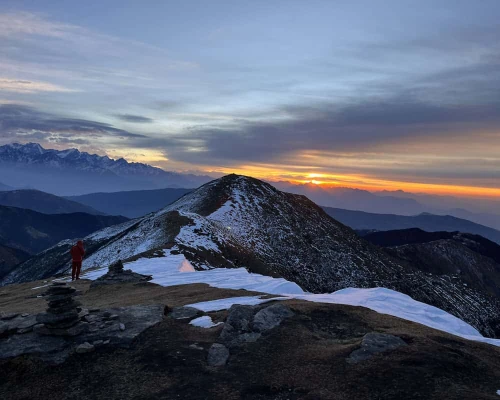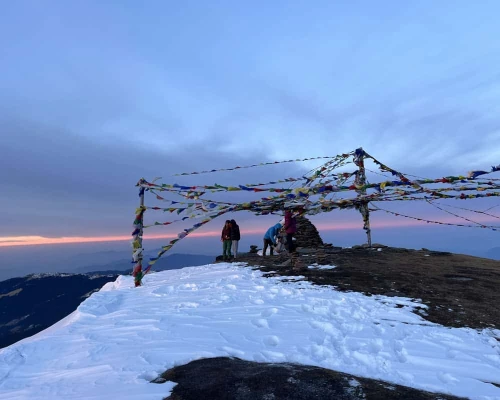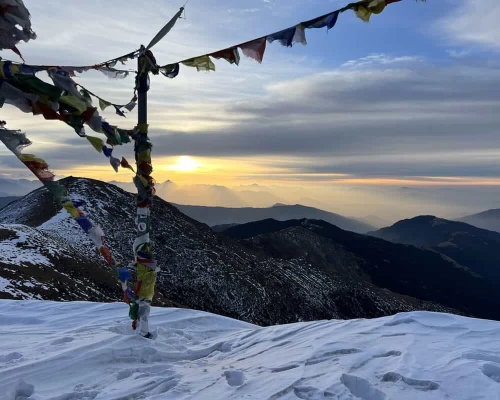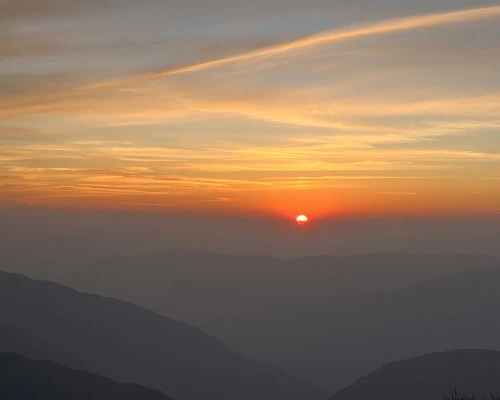13-Day Pikey Peak Trek Highlights
- Explore the culturally rich and unique Lower Everest Region.
- Walk the uncrowded Pikey trail with peace away from the headache of mass tourism.
- Explore Picturesque Rhododendron Forests along the Serene Pikey Peak trail.
- Climb the most picturesque Pikey Peak Summit at 4,065m/13,335 feet for Sunrise and panoramic vistas.
- Enjoy jaw-dropping 360° panoramas including Mt. Everest, Kanchenjunga, and many other famed Himalayan Peaks
- Witness the Tamang and Sherpa Cultures by stopping at their unique Traditional Villages:
- Interact with the Sherpas, the legendary mountaineers, and learn their centuries-old traditions.
- Find the landscape variation from lush rhododendron forests to wide alpine meadows.
- Explore the great alternative to the popular routes of Everest Base Camp or Annapurna Base Camp.
- Discover your spirituality at Thupten Chholing Monastery and Chiwong Gomp.
13-Day Pikey Peak Trek Overview
Pikey Peak Trek is now getting very trendy and is becoming one of the most popular new trekking routes in the Solu region of Nepal. The 13-Day Pikey Peak Trek is an epic journey that uncovers the breathtaking beauty of the Himalayas in Nepal. Travelers on this classical trek are greeted by a jaw-dropping panorama of majestic snow-capped peaks.
It is certainly quite amazing to discover lush green hidden valleys, and picturesque Sherpa villages nestled amidst the rugged terrain. This beautiful teahouse trek offers a mesmerizing blend of natural wonders, where every step reveals a new vista that leaves trekkers in surprise.
It is truly believed that Pikey Peak was Edmund Hillary's favorite spot to view Mt. Everest. This belief is certainly very true as it showcases the most beautiful view of the world's highest peaks among other famed mountains.
The highlight of the Pikey Peak Trek is undoubtedly the sunrise view from the summit. In the morning, before the sun the dawn paints the horizon and the towering peaks with orange. This scene casts a spellbinding feeling and beauty that will remain in your memory forever. The serenity of the surrounding landscape creates an atmosphere of tranquility and connects you deeply with nature.
As you trek the valley you will come across to ample traditional settlements of Tamangs and Sherpa people. The Tamangs and Sherpas are known for their friendliness and hospitality. The warm hospitality of the local communities adds a soothing atmosphere and a homely feeling. The Pikey Peak Trek is a true gem for adventurers seeking both physical challenges and imperial beauty in the heart of the Himalayas.
This 13-Day Pikey Peak Trek offers breathtaking panoramic views of the Himalayan range. This grandiose view includes Mount Everest, Makalu, Kanchenjunga, and many other peaks. The trek is named after Pikey Peak, which stands at an altitude of 4,065 meters (13,335 feet) and is known for its stunning sunrise and sunset views.
The Pikey Peak Trek is a relatively new and less crowded trekking route compared to other famous treks in Nepal like Everest Trekking or Annapurna Trekking. It is an excellent choice for those looking for a less touristy experience while still enjoying the beauty of the Himalayas.
One of the highlights of the 13-Day Pikey Peak Trek is the cultural experience it offers. Along the way, you'll pass through several traditional Sherpa and Tamang villages, where you can witness their unique lifestyle, visit monasteries, and learn about their religious practices.
Best time to do 13-Day Pikey Peak Trek:
The best time for this 13-Pikey Peak Trek is during the Spring and Autumn season in Nepal
- SPRING (March to May). Spring has always been the best season to trek in any trekking destination in Nepal.
- AUTUMN (September to November) - Not September but October and November deliver great weather with crystal clear views.
- WINTER (December to February) - Due to climate change trekking in winter in Nepal is getting quite popular these days. If the sub-zero temperature doesn't bother you, then you should opt for winter trekking to Pikey Peak as winter offers the most beautiful crystal clear weather.
What is the Accommodation and Food like at Pikey Peak Trek:
Accommodation in the Pikey Peak Trek is evolving with time but as for now the accommodation facilities along the route are pretty BASIC. The basic teahouses provide simple but clean rooms that are perfect for trekkers looking for a budget-friendly option. These rooms have the essentials, such as beds, blankets, and shared toilets. Though the facilities may be basic, they offer a cozy and rustic charm that adds to the trekking experience.
They also have communal dining areas where trekkers can gather and enjoy traditional Nepali meals together. These dining areas often have a warm and inviting atmosphere, making them a great place to relax and socialize after a long day of trekking.
Regardless of basicness, you can expect a warm and friendly welcome from the people and lodge owners. They take pride in providing a homely atmosphere and ensuring that their guests have a comfortable stay.
It is worth noting that due to the remote location of the Pikey Peak Trek route, the availability of accommodation may vary, especially during peak trekking seasons.
when it comes to food, they offer every variety of food options that a teahouse could offer. Until now there have been no complaints whatsoever over the food and the hygiene practice that Pekey Peak Teahouses has to offer to the trekker.
However, the 13-Day Pikey Peak Trek is a great option for nature lovers, adventure enthusiasts, and those seeking a less crowded trekking experience in Nepal. It offers a combination of stunning mountain views, cultural exploration, and a chance to enjoy the natural beauty of the Himalayas.
Permits Required for Pikey Peak Trekking
13-Day Pikey Peak Trek requires the following permits. However, Nepal Pyramids organized all essential permits before you arrived in Kathmandu.
- Gaurishankar Conservation Area Permit (GCAP): Since Pikey Peak lies within the protection of the Gaurishankar Conservation Area Project (GCAP) this permit is mandatory. The permit can be obtained from the Nepal Tourism Board in Kathmandu and the cost is NPR 3000 per trekker.
- TIMS (Trekkers’ Information Management System) Card: Next is the TIMS card - However it is NOT a mandatory permit as of now. TIMS can be obtained from the Nepal Tourism Board or TAAN office in Kathmandu or Pokhara and the cost will be NPR 2000 per person.










